Our verdict
- Top pick in best HYROX running shoes
Pros
- Insanely lightweight
- Awesome racing-flat vibes
- Perfect for tempo workouts
- Promotes feet strength
- Grippy outsole in wet and dry surfaces
- Reasonably priced
- Amazing airflow
- Can double for track workouts
Cons
- Limited versatility
- Not a stable ride
- Still not the most responsive midsole
Audience verdict
- Top 29% most popular running shoes
Comparison
The most similar running shoes compared
+ + Add a shoe | |||||
|---|---|---|---|---|---|
| Audience score | 88 Great! | 90 Superb! | 66 Bad! | 89 Great! | |
| Price | £140 | £110 | £140 | £150 | |
| Pace | CompetitionTempo | Daily runningTempo | Daily runningTempo | Tempo | |
| Shock absorption | High | High | Moderate | Moderate | |
| Energy return | Moderate | Moderate | Moderate | Low | |
| Traction | High | High | High | Moderate | |
| Arch support | Neutral | Neutral | Neutral | Neutral | |
| Weight lab Weight brand | 7.2 oz / 203g 7.1 oz / 201g | 8.6 oz / 245g 8.4 oz / 238g | 8.6 oz / 244g 8.6 oz / 244g | 7 oz / 198g 7 oz / 199g | |
| Lightweight | ✓ | ✓ | ✓ | ✓ | |
| Drop lab Drop brand | 9.8 mm 8.0 mm | 8.2 mm 9.0 mm | 11.3 mm 8.0 mm | 9.0 mm 8.0 mm | |
| Strike pattern | HeelMid/forefoot | HeelMid/forefoot | Heel | HeelMid/forefoot | |
| Size | True to size | Half size small | True to size | True to size | |
| Midsole softness | Balanced | Balanced | Balanced | Balanced | |
| Difference in midsole softness in cold | Small | Small | Small | Small | |
| Toebox durability | Decent | Bad | Decent | Good | |
| Heel padding durability | Bad | Good | Good | Decent | |
| Outsole durability | Decent | Decent | Good | Good | |
| Breathability | Breathable | Breathable | Breathable | Moderate | |
| Width / fit | Medium | Wide | Medium | Medium | |
| Toebox width | Medium | Medium | Medium | Medium | |
| Stiffness | Moderate | Moderate | Moderate | Flexible | |
| Torsional rigidity | Moderate | Moderate | Stiff | Flexible | |
| Heel counter stiffness | Moderate | Flexible | Stiff | Moderate | |
| Heel lab Heel brand | 32.2 mm 31.5 mm | 34.9 mm 35.0 mm | 36.5 mm 36.0 mm | 28.7 mm 28.0 mm | |
| Forefoot lab Forefoot brand | 22.4 mm 23.5 mm | 26.7 mm 26.0 mm | 25.2 mm 28.0 mm | 19.7 mm 20.0 mm | |
| Widths available | Normal | NormalWide | Normal | Normal | |
| Orthotic friendly | ✓ | ✓ | ✓ | ✓ | |
| Season | SummerAll seasons | SummerAll seasons | SummerAll seasons | All seasons | |
| Removable insole | ✓ | ✓ | ✓ | ✓ | |
| Ranking | #261 Top 40% | #46 Top 13% | #371 Bottom 1% | #96 Top 26% | |
| Popularity | #190 Top 29% | #155 Top 42% | #143 Top 39% | #176 Top 48% |
Who should buy
The Hyperion 2 shines as a refreshing shift from the overwhelming trend of ultra-cushioned, high-stack designs. And we believe is a stellar pick for:
- Runners craving a classic, low-to-the-ground ride that recalls racing flats from years past.
- Brooks aficionados seeking an interval trainer to seamlessly complement the Hyperion Max 2 in their running rotation.
- Athletes seeking a streamlined running shoe that boosts foot strength and offers an exhilarating ride at faster paces.

Who should NOT buy
We think the Hyperion 2 offers a solid upgrade over its predecessor, but it still lacks the superfoam needed to deliver top-tier energy return. In our view, if you’re after maximum bounce and responsiveness, the Adidas Adizero Adios 8 and the Nike Pegasus Plus offer superior bounce, especially for midfoot and forefoot strikers.
Additionally, we believe the Hyperion 2 may feel a bit underwhelming for those seeking top performance. While it’s lightweight, the absence of a carbon plate limits its potential. The obvious choice is the Brooks Hyperion Elite 4, as it's the beefed-up version of this model. Alternatively, the Adidas Adizero Takumi Sen 10 features a similar running experience but with noticeably greater bounce.
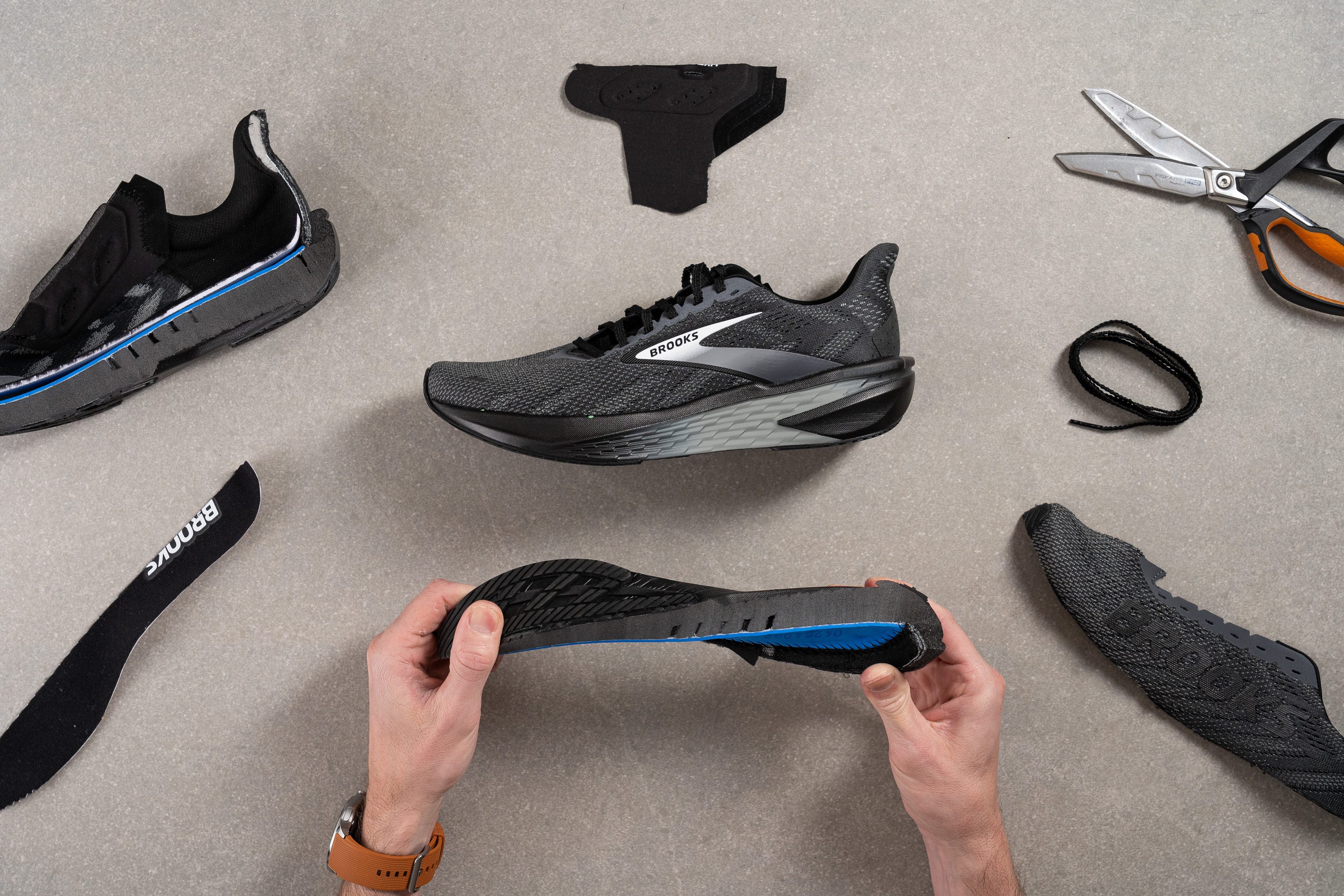
Cushioning
Shock absorption
Using the ASTM F1976 test, we found that the Hyperion 2 delivers better impact dampening than its slim profile suggests. Despite having less stack than the Ghost and Glycerin, it packs more heel cushioning with 130 SA!

| Hyperion 2 | 130 SA |
| Average | 129 SA |
Energy return
Energy return is also better than in its cousins, hitting 58.9% in the heel and a solid 62.7% in the forefoot. Still lower than other tempo shoes, but it feels fair given the price.
| Hyperion 2 | 58.9% |
| Average | 58.5% |
Heel stack
We just noted our amazement at the Hyperion 2's lightweight design, especially given its increased stack height. Here’s the detail: 32.2 mm in the heel—a height similar to most daily trainers—making this shoe more inviting for rearfoot strikers than ever.
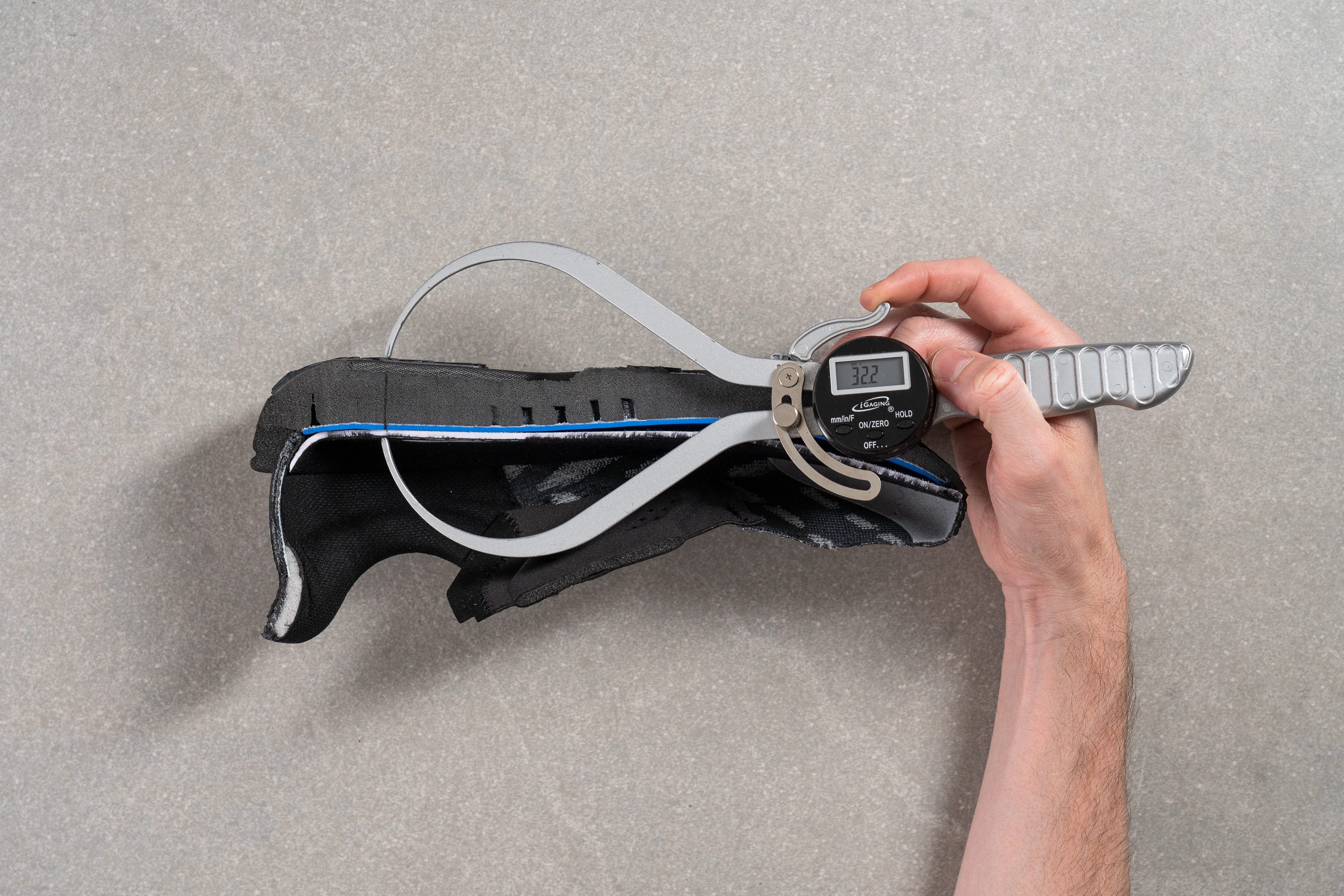
| Hyperion 2 | 32.2 mm |
| Average | 34.8 mm |
Forefoot stack
The forefoot receives a bigger boost, and in our view, it’s a smart improvement. While this shoe’s essence is to deliver a natural ride with plenty of feedback from the ground, that's now paired with added forefoot protection, which we believe was needed.
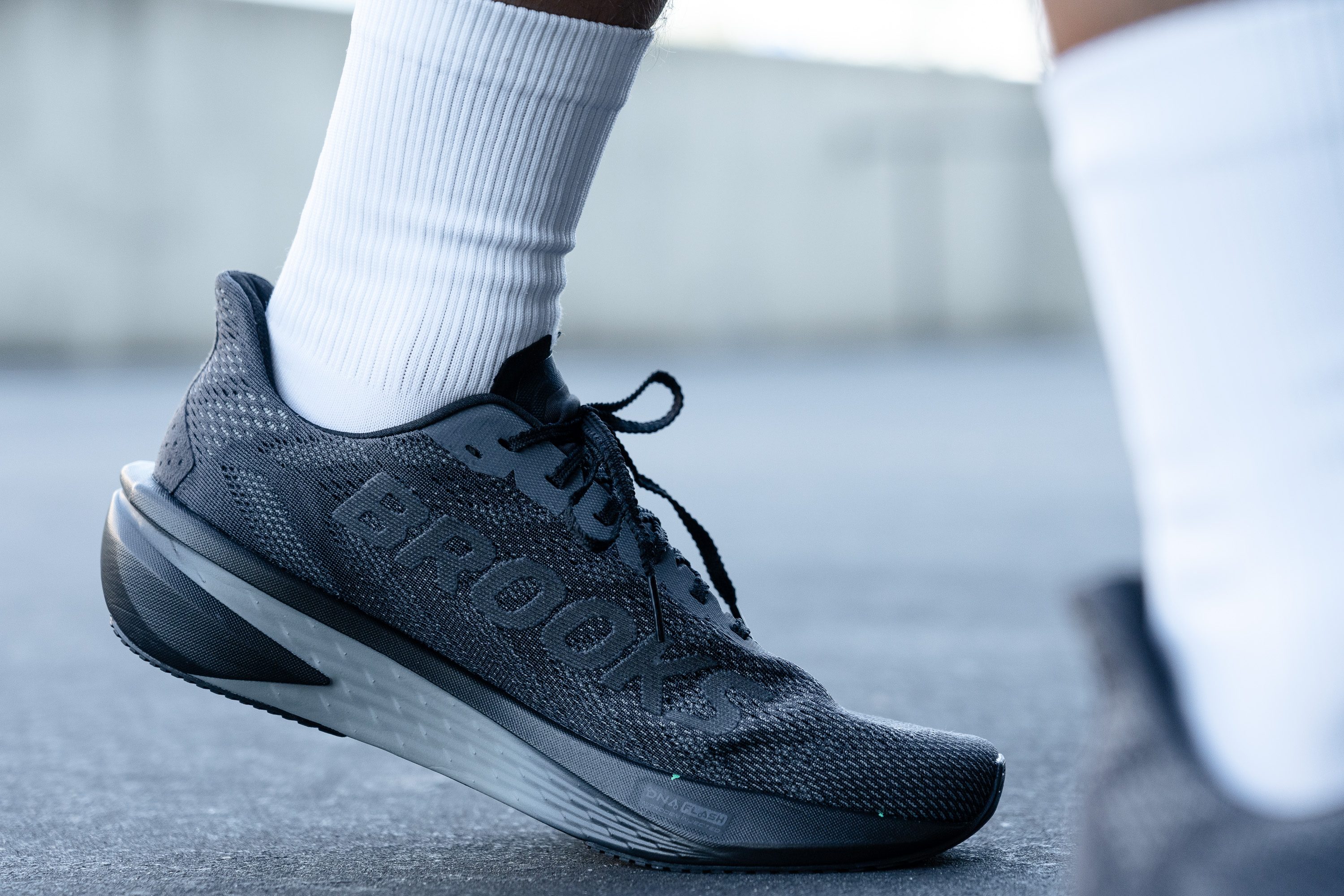
The previous version felt overly thin in this area, but with 22.4 mm underfoot, it’s now better suited for medium-distance runs—think 15K or even 20K. Beyond that, though, it starts to feel limited.
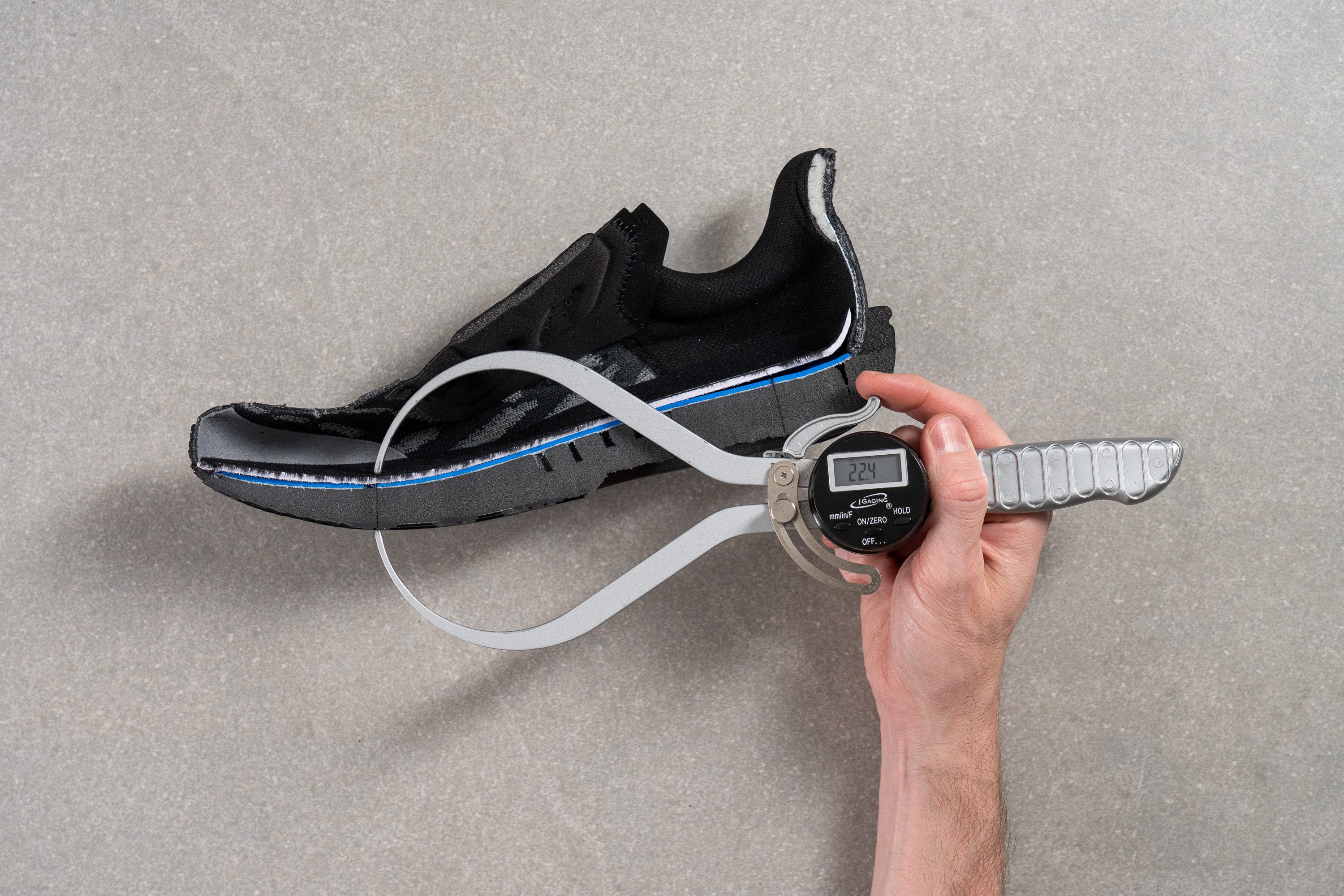
| Hyperion 2 | 22.4 mm |
| Average | 26.2 mm |
Drop
Brooks claims an 8 mm drop for this shoe, but our measurements found it at 9.8 mm. This slight variance doesn’t significantly affect biomechanics—it remains a heel-striker-friendly shoe.
We believe that all footstrikes can enjoy a smooth running experience with this shoe; however, if you are a forefoot striker and prefer a lower drop, consider the Saucony Kinvara 15 instead.

| Hyperion 2 | 9.8 mm |
| Average | 8.6 mm |
Midsole softness
The most significant update in the Hyperion 2 is the midsole, now featuring Brooks’ new DNA Flash v2—a more resilient, energy-returning version of the supercritical EVA foam used in their lightweight trainers. In our experience, this midsole felt notably bouncier.
However, it's not softer; in fact, it’s a touch firmer at 26.1 HA! This firmness isn’t a drawback, though—shoes with a low stack height and overly soft midsoles tend to bottom out quickly, especially as the foam begins to wear. It's also worth noting that nitrogen-infused foams like DNA Flash v2 typically feel softer than the durometer suggests, thanks to their airier composition.
With the increased stack height and slightly firmer formulation, there’s less ground feel compared to the first version. But don't worry—the connection to the ground is still there!
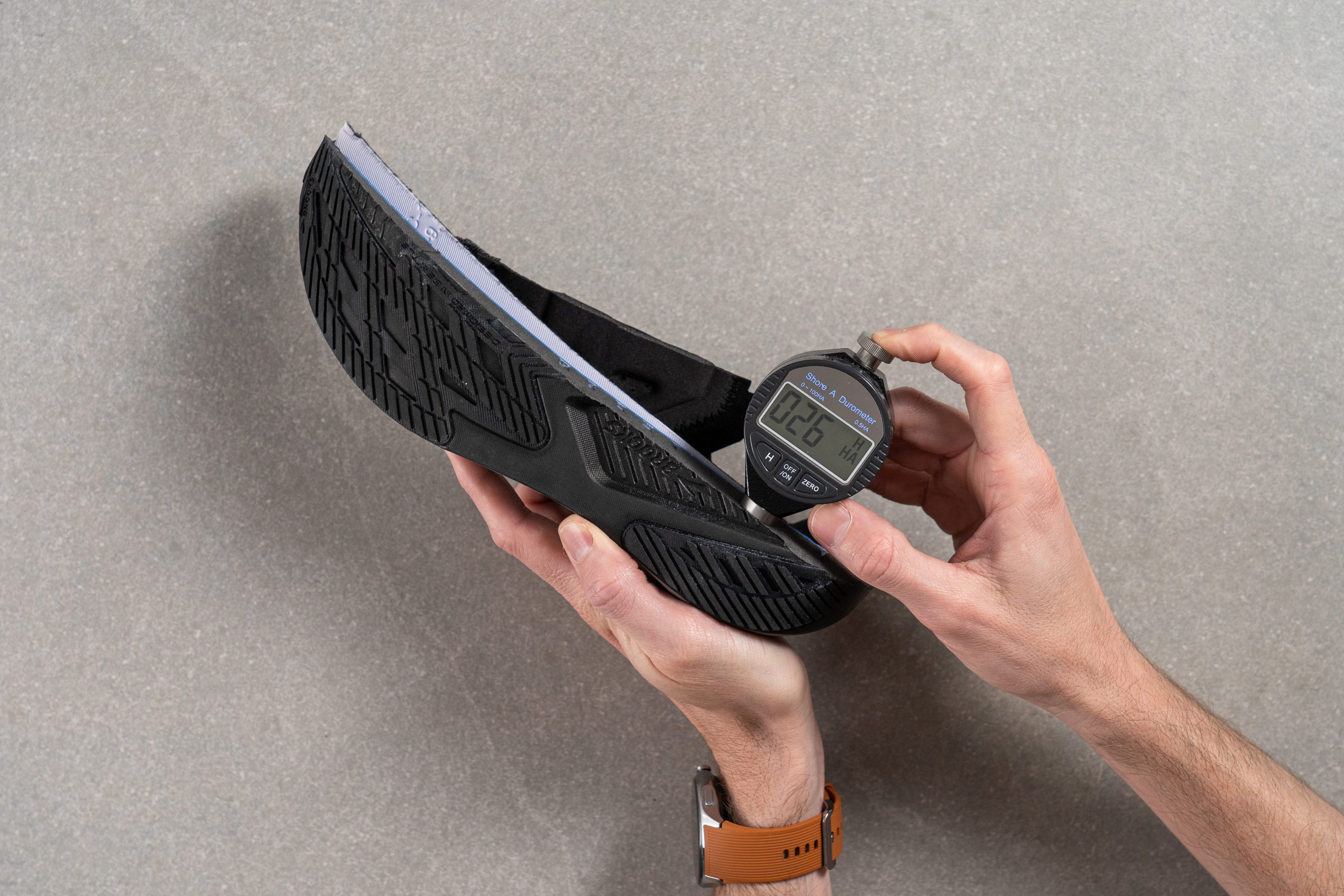
| Hyperion 2 | 26.1 HA |
| Average | 20.4 HA |
Rocker
With a midsole this thin (by today’s standards!) and no plate at all, Brooks had no need to add a huge rocker—typically used to counteract stiffness, which isn’t an issue here.
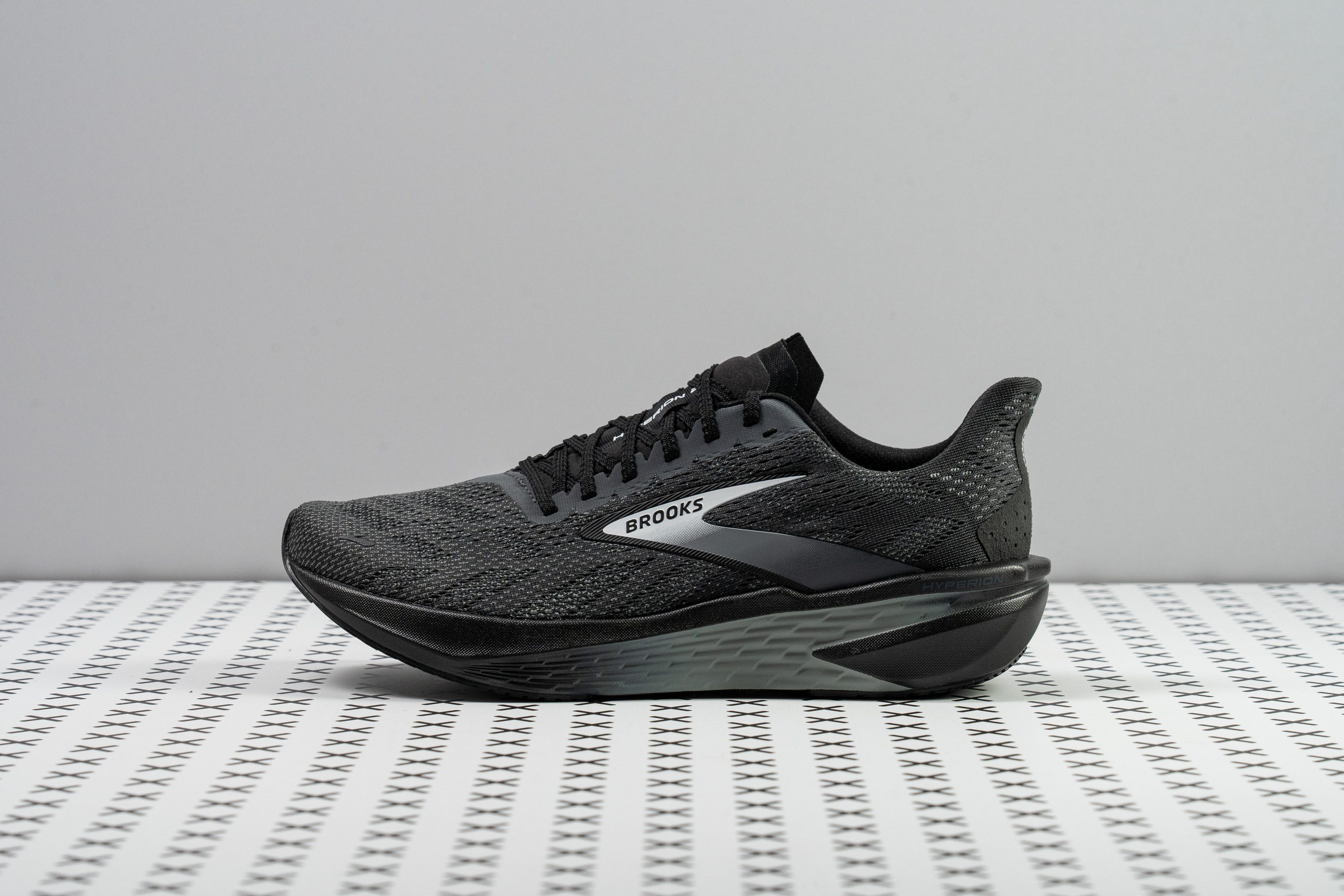
There is, however, a subtle toe spring that adds an interesting, helpful boost, especially for forefoot strikers. Even with that, the ride remains as natural and unassisted as it gets.

Size and fit
Size
Brooks Hyperion 2 fits true to size (63 votes).
Width / Fit
This shoe wasn’t built as a daily workhorse but as a lightweight, performance-driven trainer. That’s why we were happy with the snugger, tighter fit that we felt throughout the entire shoe, especially in the midfoot area.
Our first measurement came in at 94.5 mm, which confirmed our initial impression.
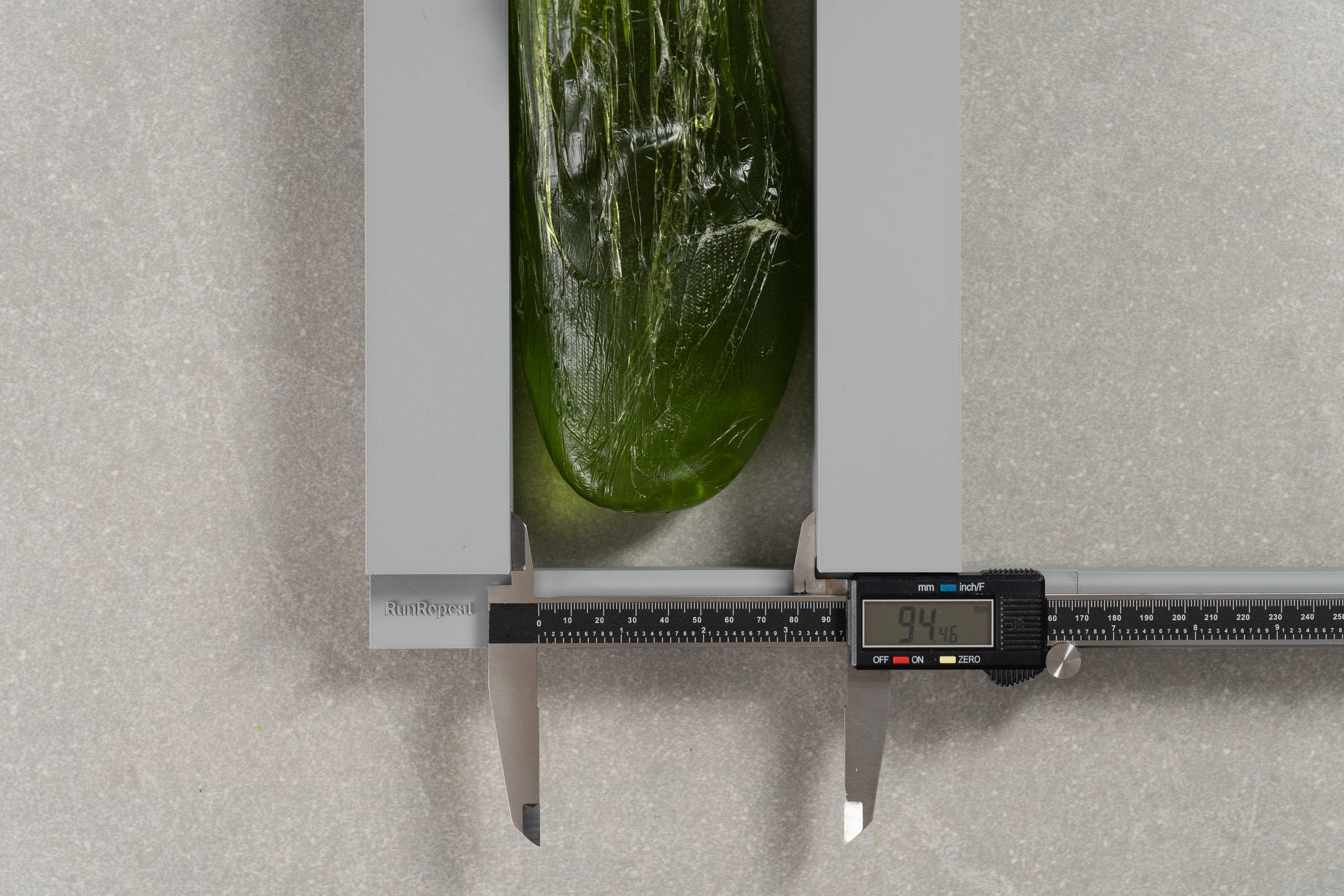
| Hyperion 2 | 94.5 mm |
| Average | 95.1 mm |
Toebox width
We were pleasantly surprised by some decent room for toe splay, as the toebox doesn’t taper sharply at 73.6 mm. That's not very usual in Brooks tempo shoes!
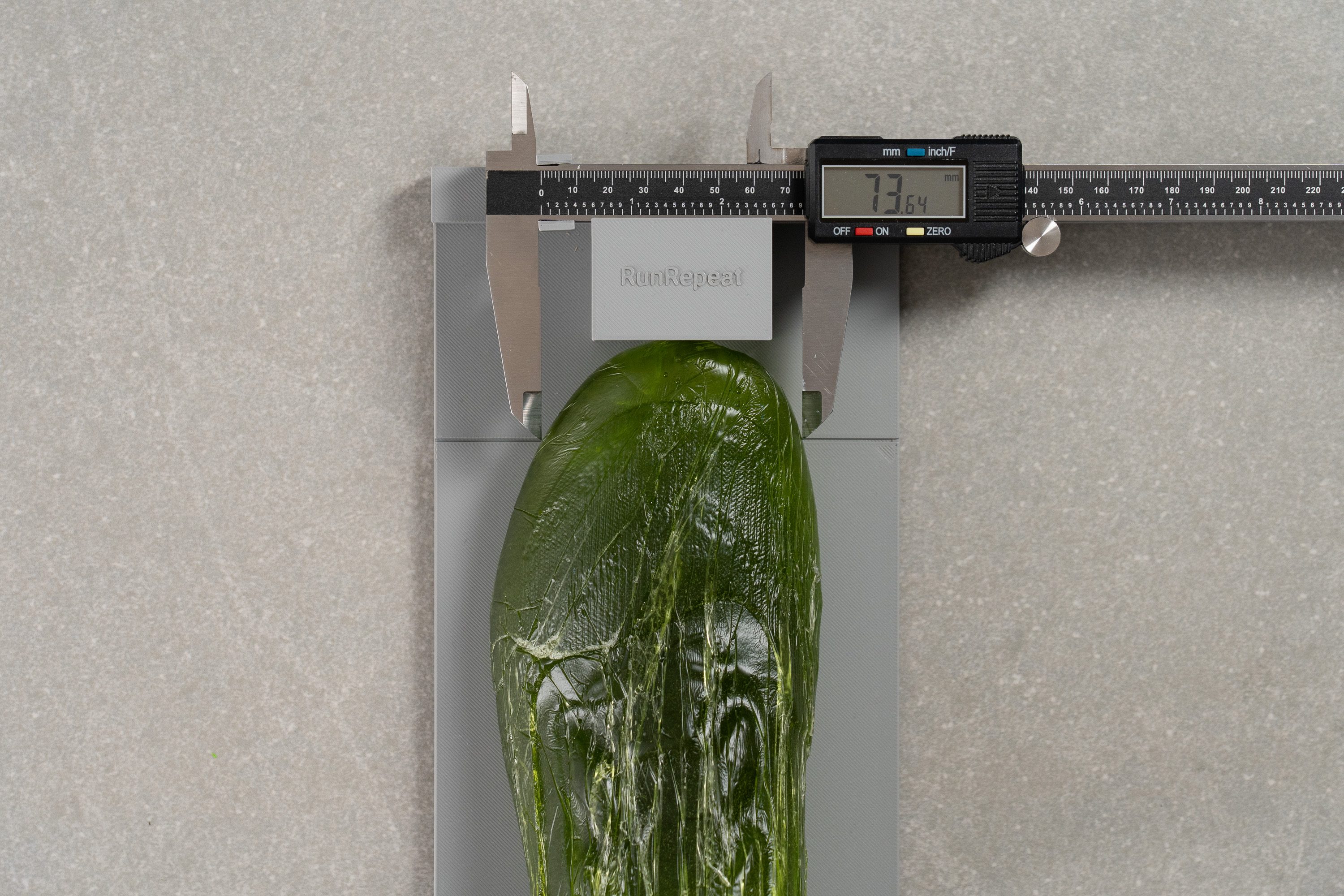
| Hyperion 2 | 73.6 mm |
| Average | 73.2 mm |
Toebox height
Brooks addressed many fit issues from v1, and it’s evident here with a well-balanced toebox height of 27.7 mm, providing comfort and improved functionality.
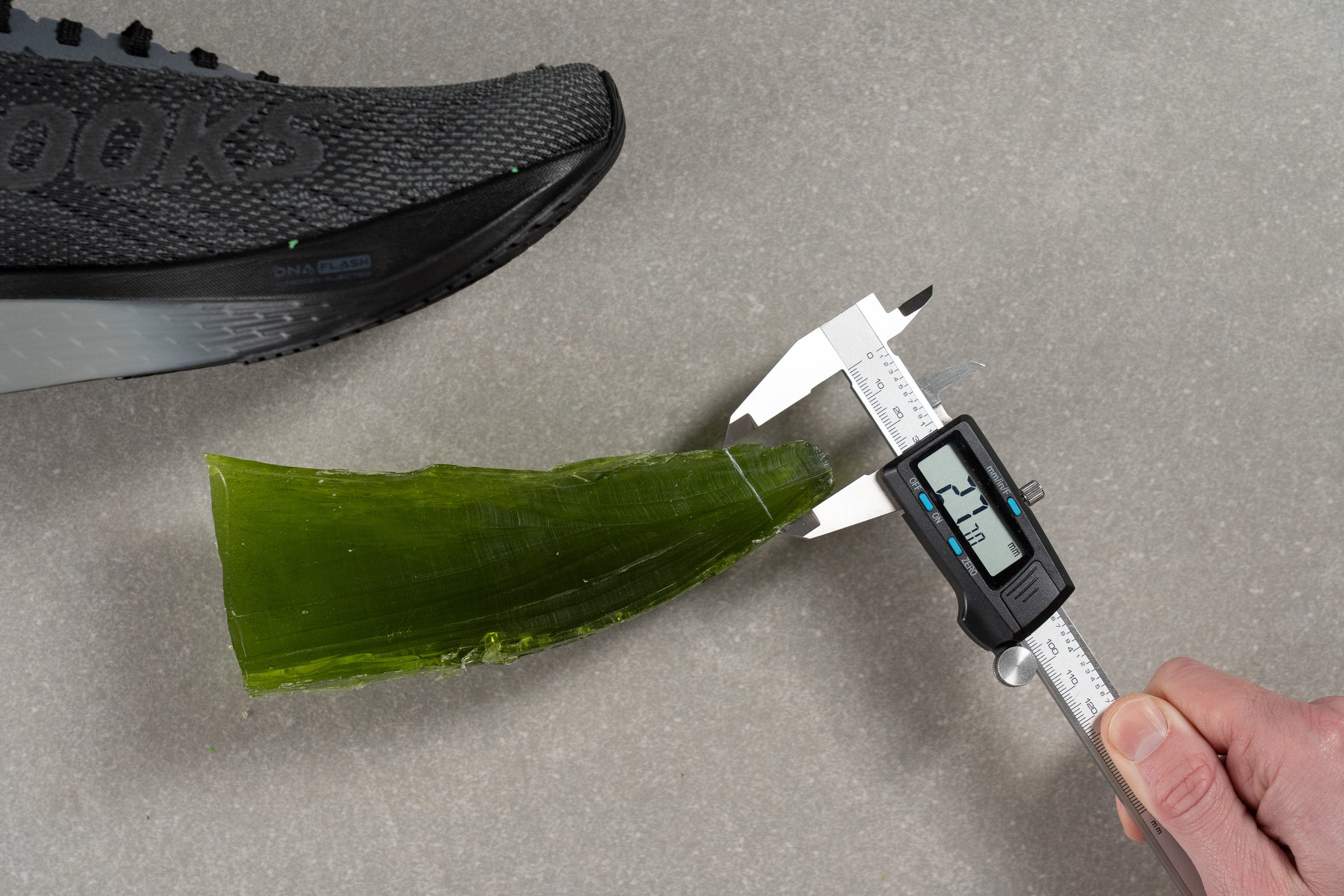
| Hyperion 2 | 27.7 mm |
| Average | 27.1 mm |
Traction / Grip
Traction test
The Brooks Hyperion 2's outsole made our tempo workouts feel surefooted even on wet concrete. We didn't experience any hints of slippage when picking up the pace or turning around the corner.
Following the SATRA TM144 grip test method, we recorded the shoe's friction score at 0.51 which is a solid result for a road running shoe indeed.
| Hyperion 2 | 0.51 |
| Average | 0.48 |
Outsole design
The outsole uses RoadTack rubber (just like most Brooks daily trainers) and we’re glad to report that both the forefoot and heel have plenty of rubber coverage, which is great to see in a lightweight shoe.
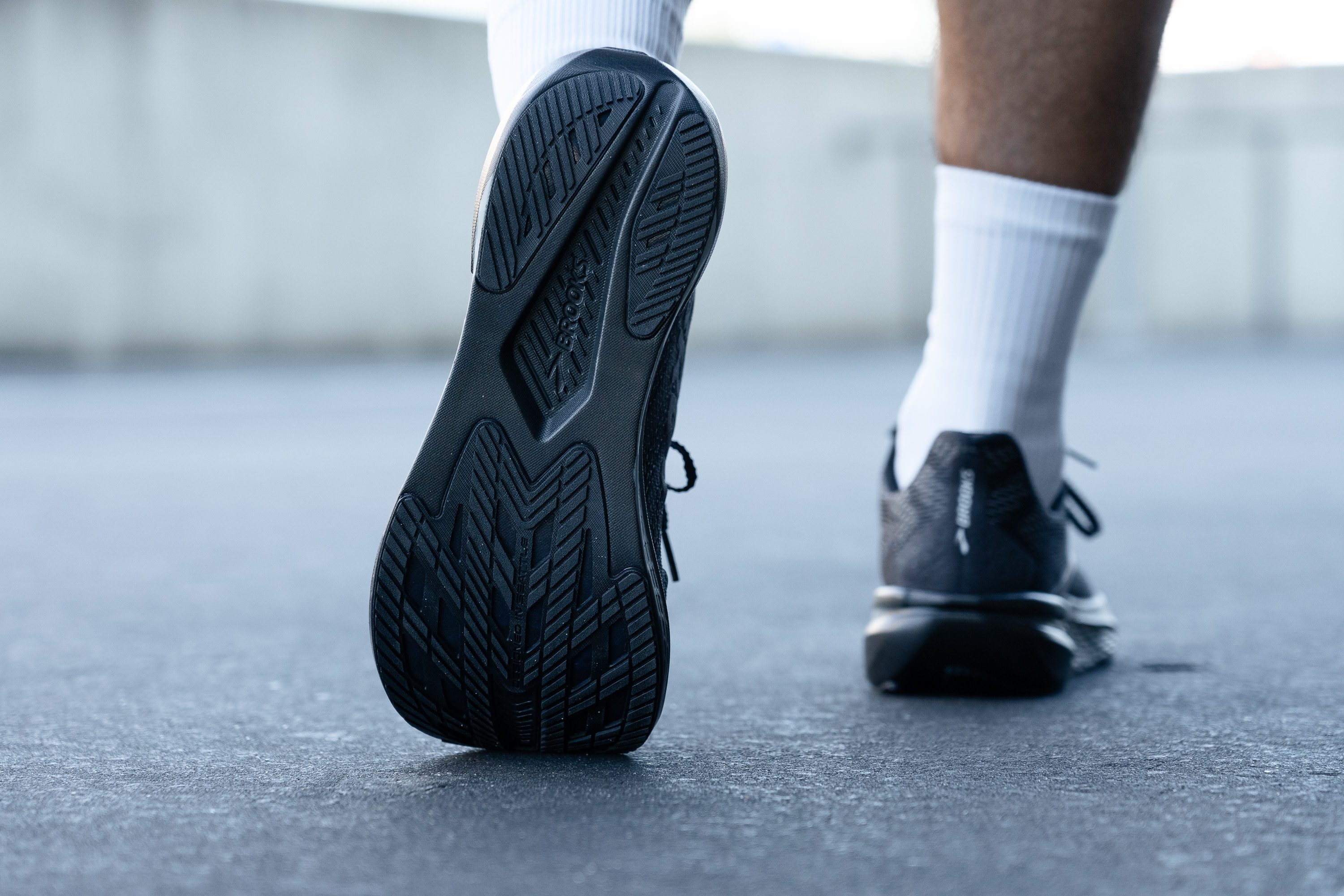
Flexibility / Stiffness
We confirmed before that the Hyperion 2 lacks a plate, features a moderate stack height, and comes with an outsole full of flexibility-enhancing grooves.
To put a number to its longitudinal flexibility, we secured the Hyperion 2 to our table and pushed it to a 30-degree angle. It only required 13.0N of force to achieve this bend, a result that's below the average running shoe.
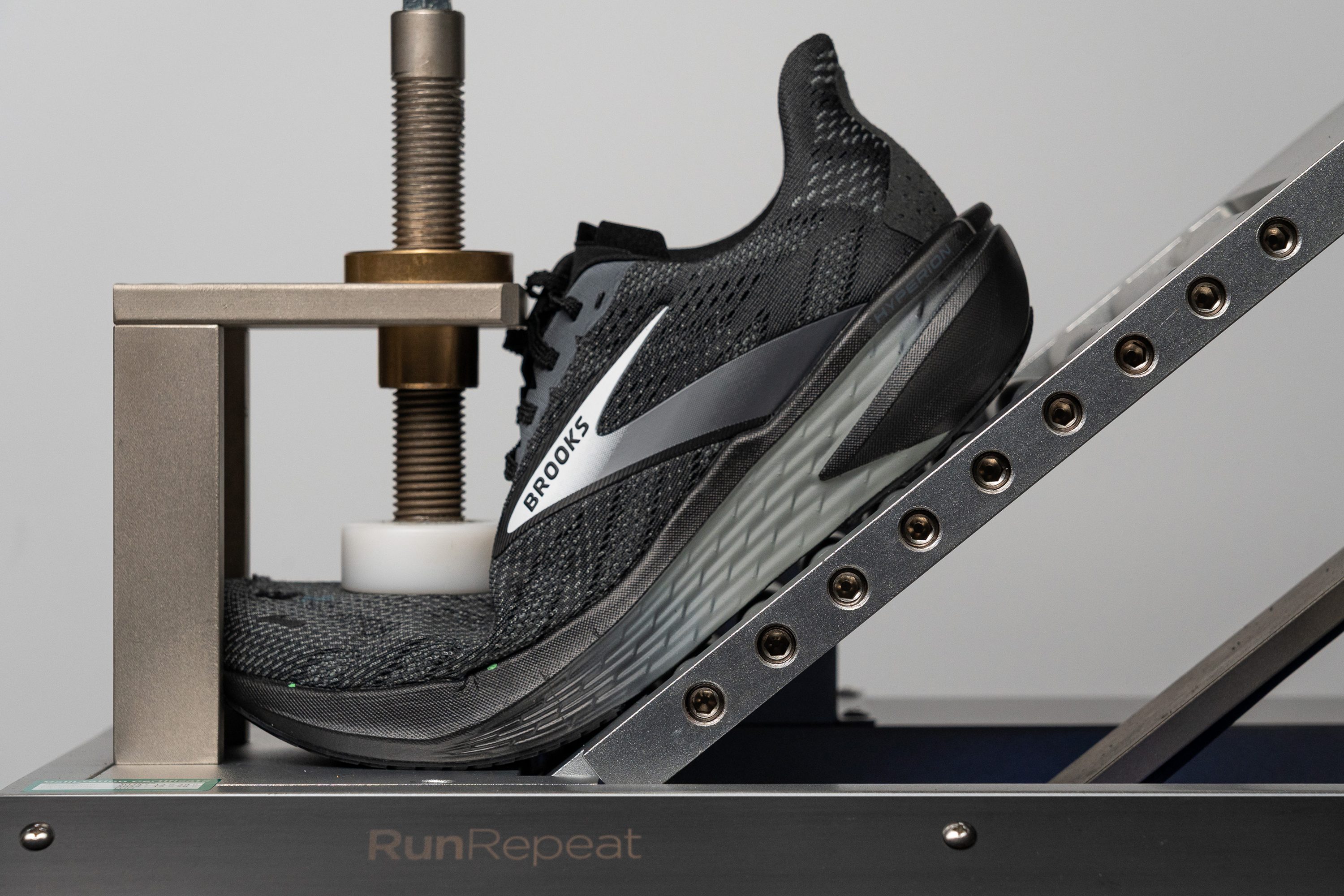
| Hyperion 2 | 13.0N |
| Average | 15.3N |
Weight
At 7.44 oz (211g), the original Hyperion was already a feather-light, sub-8-oz running shoe with few rivals in its weight class. But Brooks has taken it further—this second-generation model trims down to an impressive 7.2 oz (203g)...despite packing even more foam underfoot!
And it genuinely feels almost weightless. In our experience, this is one of those shoes where you sometimes forget you’re even wearing it!
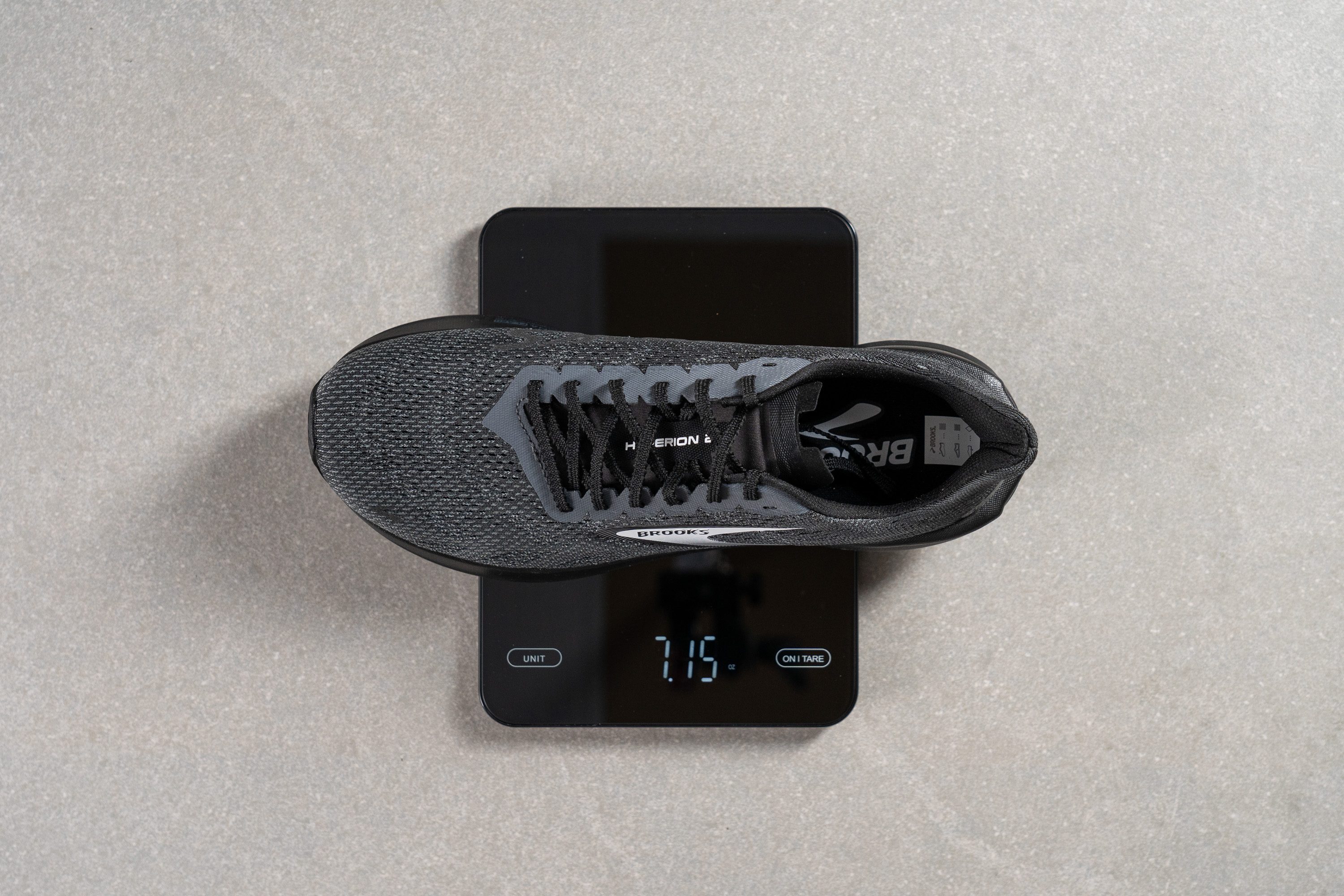
| Hyperion 2 | 7.2 oz (203g) |
| Average | 9.3 oz (264g) |
Breathability
Over the past few years, we concluded in the lab that while Brooks may lag behind other brands in cutting-edge foam technology, they’re a front-runner when it comes to uppers. With the Hyperion 2, they’ve once again impressed us.
We found the engineered mesh upper to be exceptionally breathable, delivering cool, airy comfort without compromising durability. In our view, this makes it a superb choice for a performance trainer, and we were quick to award it a perfect 5 out of 5 for ventilation.
Using our LED flashlight, we saw how the Hyperion 2 maintains ventilation from the forefoot through the midfoot, only becoming more structured near the heel—ideal for those hot summer runs.
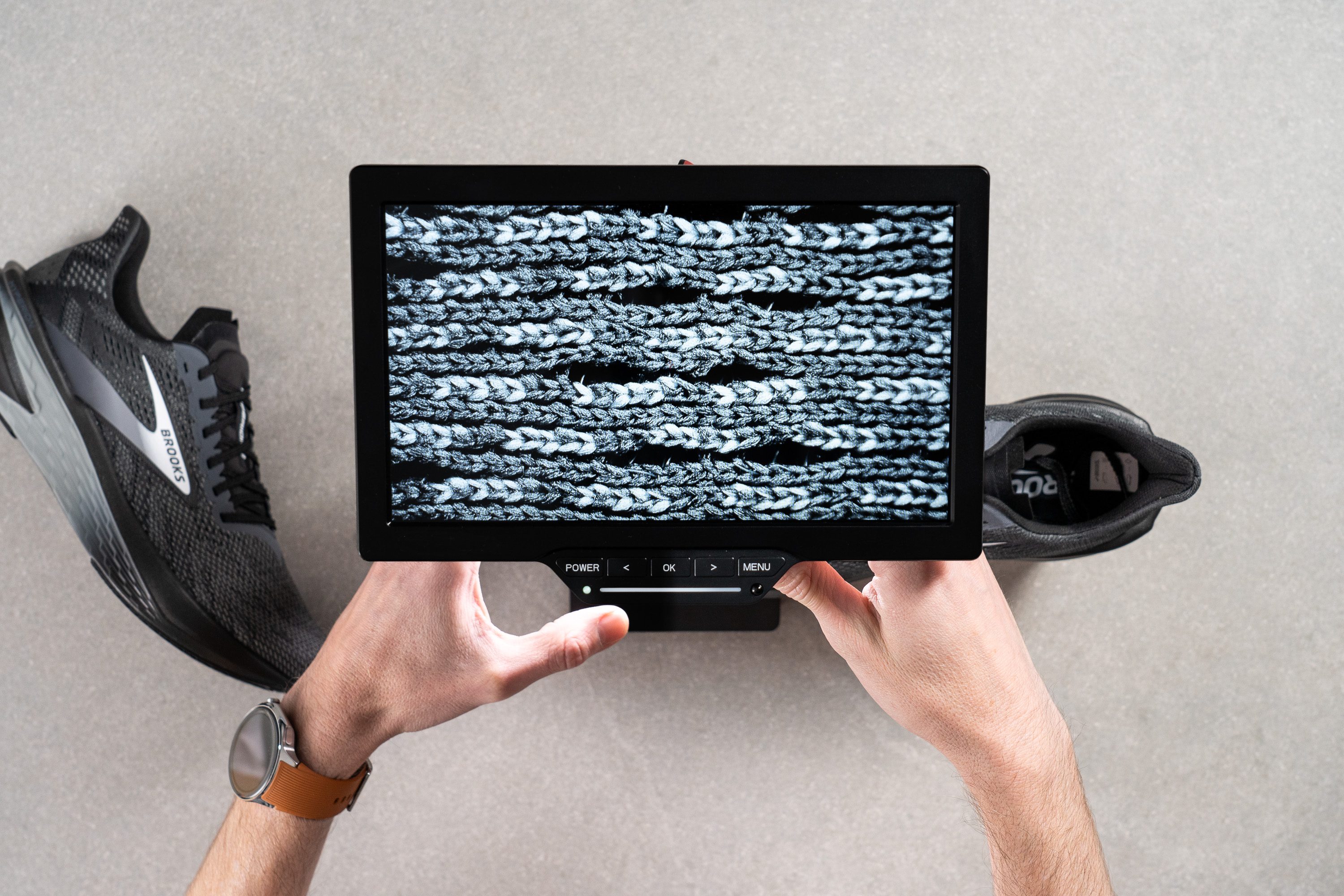
Under our microscope, we observed that Brooks uses a classic engineered mesh with varied hole sizes in different sections, designed to balance durability and airflow.

While the dark colorway we tested may not look overly breathable, we can confidently say it’s a ventilation winner! We also appreciated the generous heel padding, especially impressive in such a lightweight running shoe.
| Hyperion 2 | 5 |
| Average | 3.7 |
Stability
Lateral stability test
Considering it's a tempo-training shoe with a narrow landing platform, the Hyperion 2 feels surprisingly stable, especially in the forefoot, though the heel is a bit less supportive.
As with most streamlined shoes, the faster you run, the more stability and support it provides. And the better it feels.
Torsional rigidity
In our view, a key factor enhancing the Hyperion 2’s stability is its well-balanced torsional rigidity. Rated at 3/5, this updated rigidity level marks a change over its predecessor’s 2/5 score, which felt notably easier to twist and bend.
| Hyperion 2 | 3 |
| Average | 3.5 |
Heel counter stiffness
In contrast, the heel counter remains largely unchanged, resembling the structure found in daily trainers with a 3/5 rating. This choice works well for the Hyperion 2, as a touch of heel support helps stabilize rearfoot strikers and minimizes lateral movement—without adding excessive stiffness or requiring a super-thick piece of foam to offset it.
| Hyperion 2 | 3 |
| Average | 2.9 |
Midsole width - forefoot
Just a minute ago we mentioned that this shoe is anything but broad. And we’re thrilled about it because the market is already flooded with massive shoes!
We measured a sleek 111.3 mm in the forefoot, reminiscent of classic racing flats from a decade ago, bringing a classic, feedback-rich feel that’s increasingly rare.

| Hyperion 2 | 111.3 mm |
| Average | 114.4 mm |
Midsole width - heel
The heel is even narrower than the forefoot at just 84.5 mm. For this reason, we recommend the Hyperion 2 only to heel strikers without stability needs.
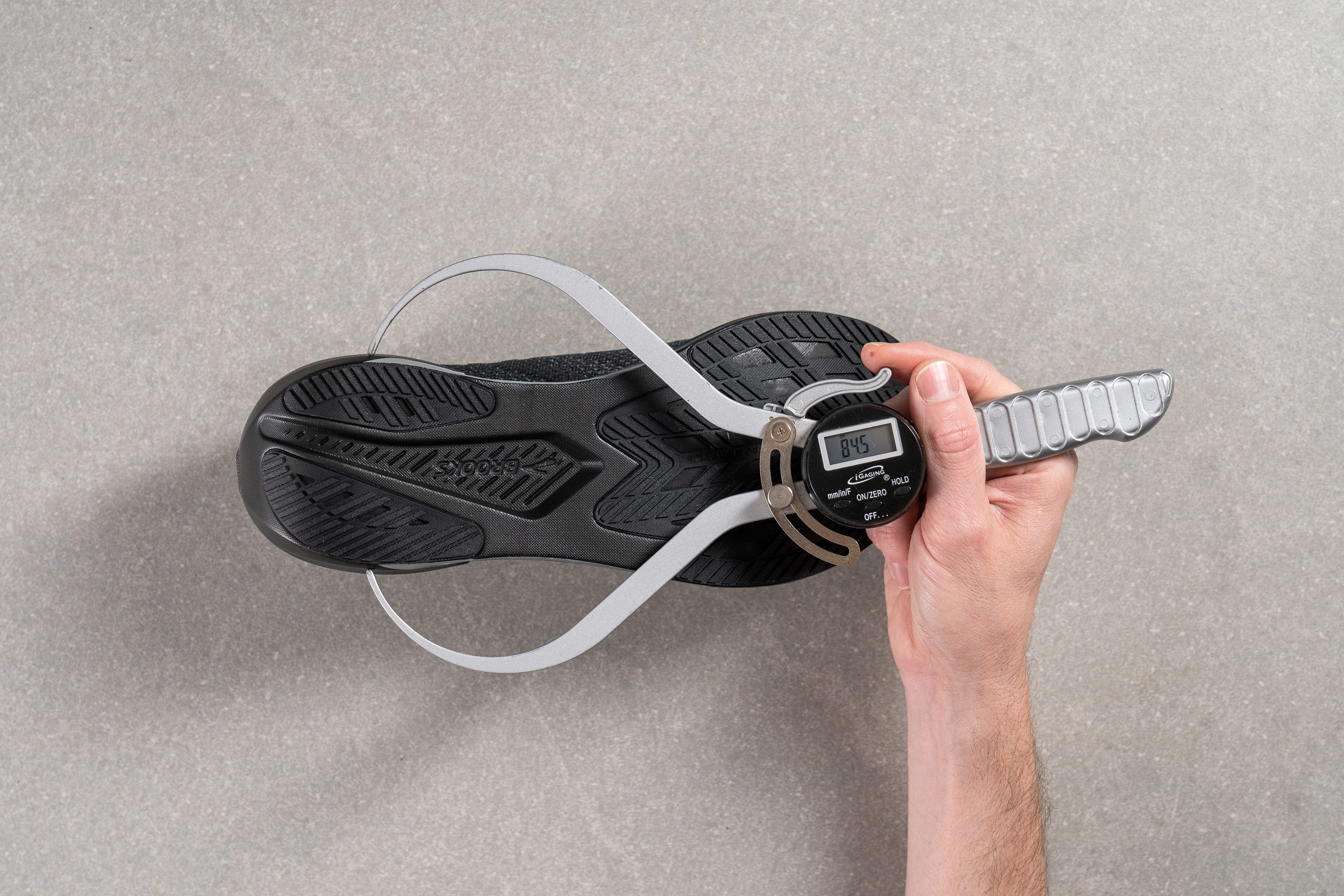
| Hyperion 2 | 84.5 mm |
| Average | 90.7 mm |
Durability
Toebox durability
This engineered mesh upper offers a super-light and breathable experience, though durability is always a concern with lighter materials, which often sacrifice strength under stress.
However, we tested the Hyperion 2 with the Dremel and were pleased with the results. Scoring a respectable 3/5, it held up on par with thicker daily trainers that typically offer enhanced wear resistance.
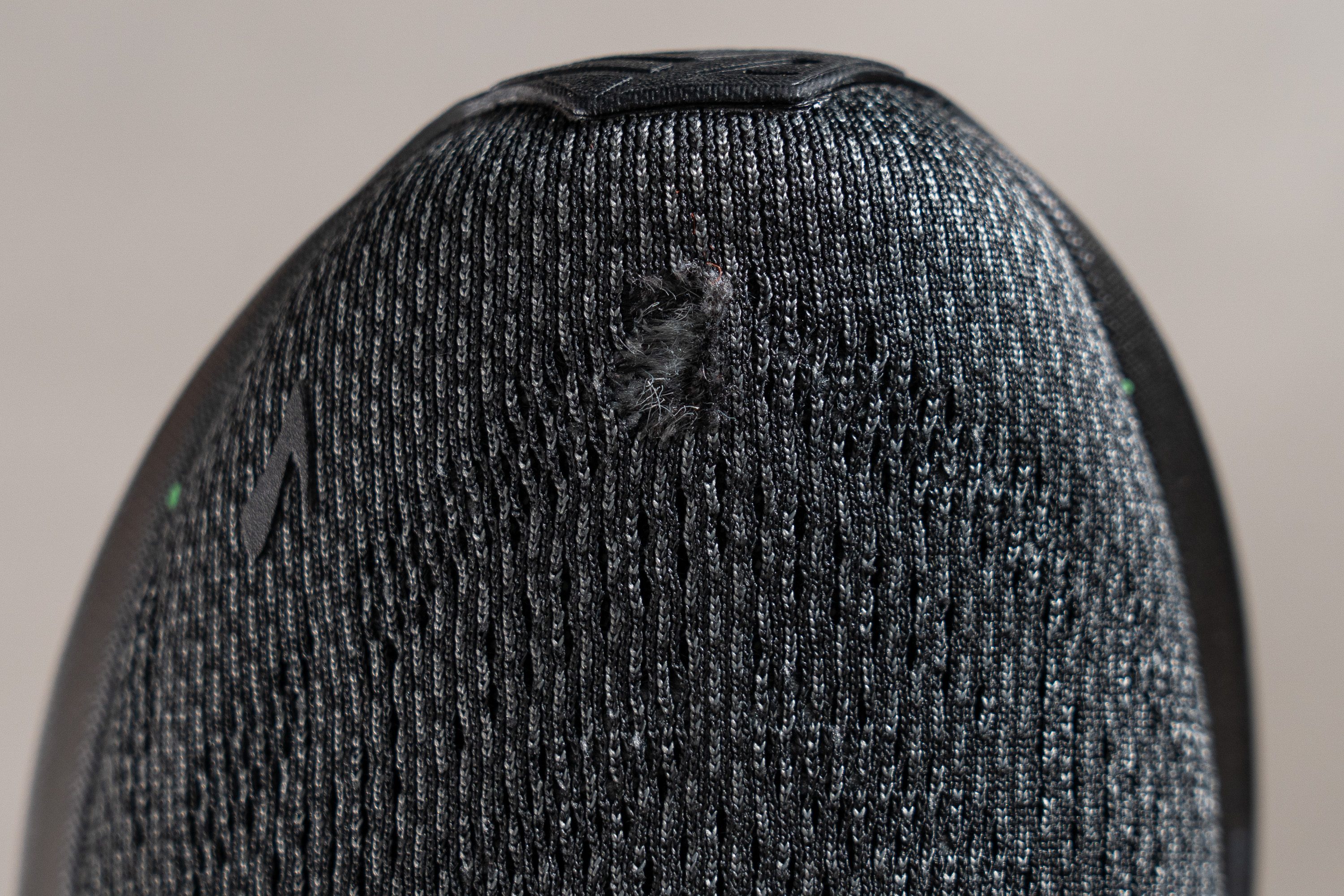
| Hyperion 2 | 3 |
| Average | 2.6 |
Heel padding durability
On the downside, the heel padding proved disappointing.
We tested it rigorously under the same Dremel specifications as before, but the results were drastically different—earning a dismal 1/5. In our view, Brooks needs to improve this area for the next Hyperion.
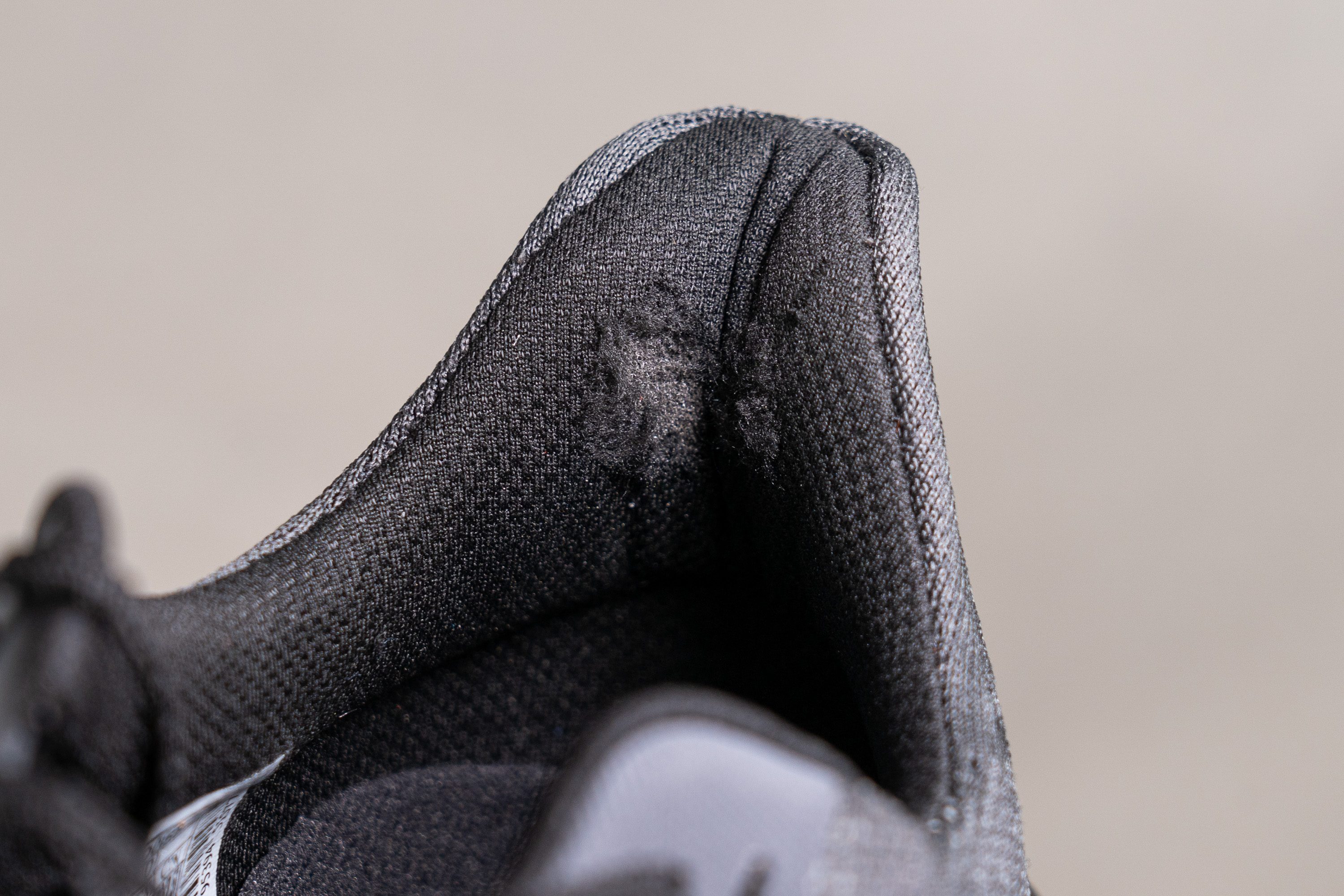
| Hyperion 2 | 1 |
| Average | 3.4 |
Outsole hardness
After mixed results on upper durability, we shifted focus to the outsole, featuring Brooks' RoadTack rubber—a dependable choice for both dry and wet surfaces.

Brooks chose a softer 72.0 HC rubber, which aligns with the shoe’s purpose as a tempo or interval trainer. In our view, sacrificing a bit of durability for enhanced grip and security makes sense here, as this shoe isn’t designed for heavy daily mileage.
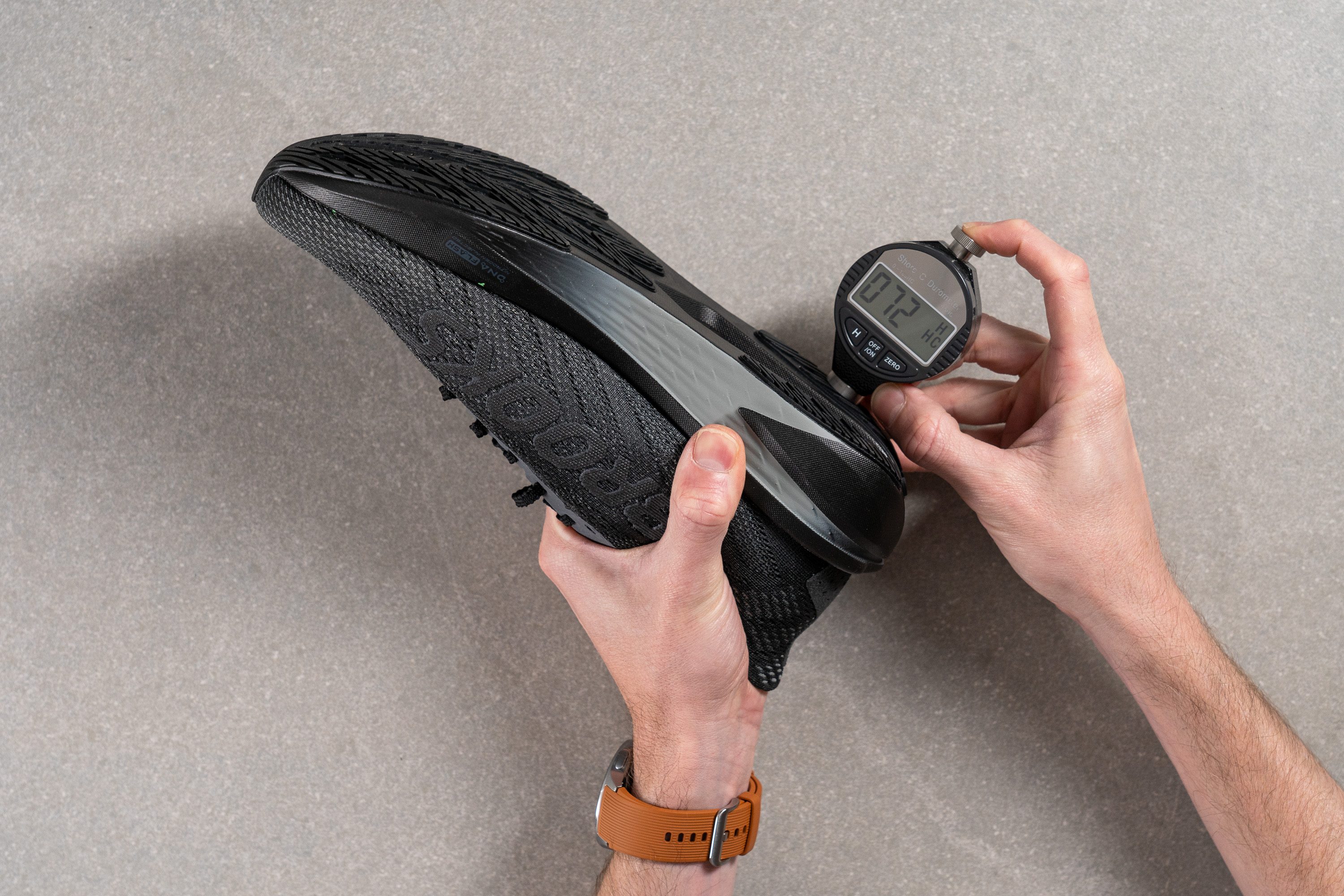
| Hyperion 2 | 72.0 HC |
| Average | 79.2 HC |
Outsole durability
In our latest Dremel test, we adjusted our method to tackle the RoadTack rubber's consistency. We ramped up the tool speed to 10K RPM and extended the duration too.
After testing, we found that the soft RoadTack rubber held up reasonably well under these conditions, although we believe it could still show a bit more resilience. The measured abrasion was around 1.2 mm—adequate, but with room for improvement.
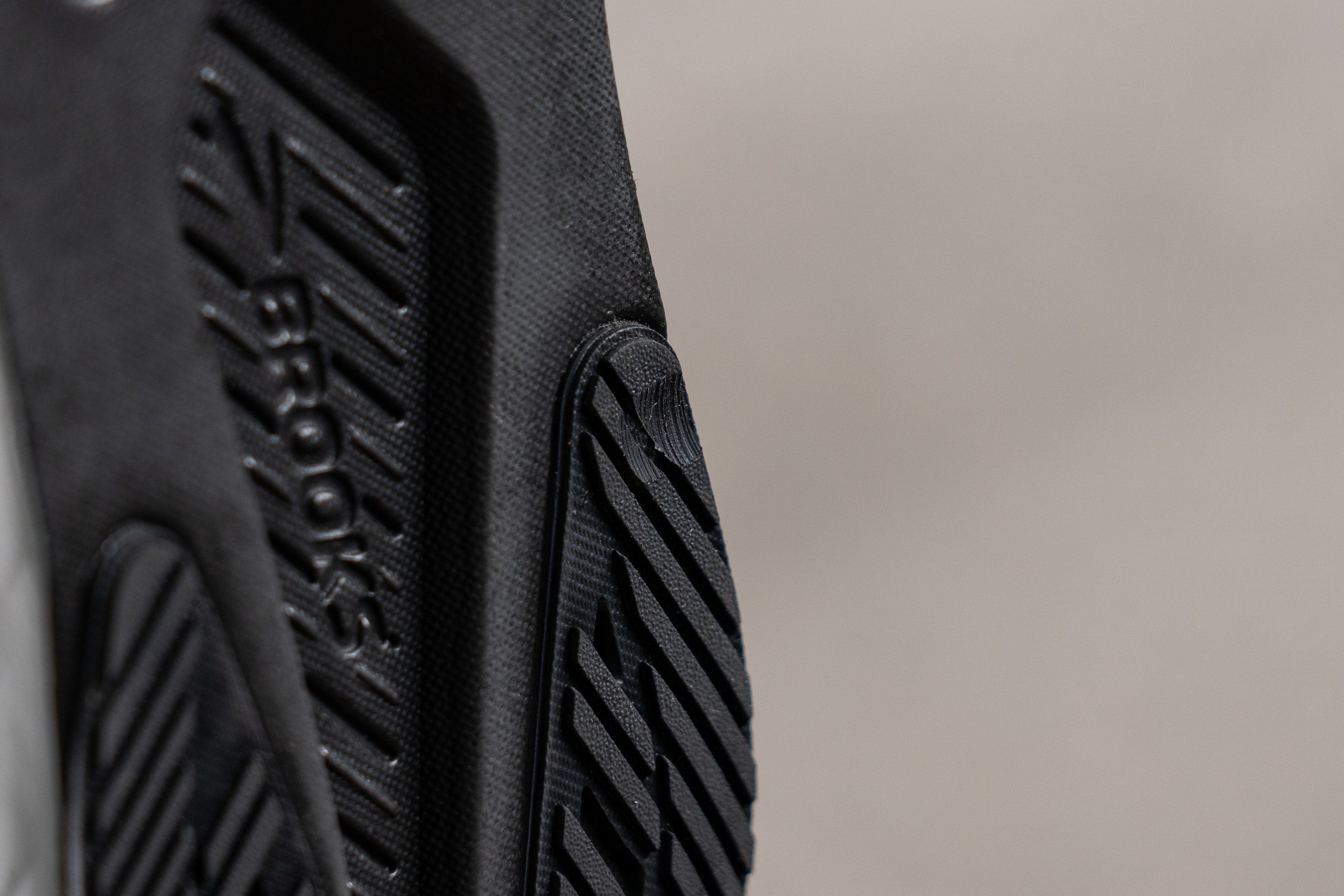
| Hyperion 2 | 1.2 mm |
| Average | 1.1 mm |
Outsole thickness
Brooks understands that even as a lightweight running shoe, durability is essential—especially since many runners will rely on it as a versatile workhorse for everything from aerobic runs to 5K or 10K races.
While we would have loved to see less than 2.9 mm of rubber to enhance its lively feel and fun factor, we get why Brooks opted for a more robust outsole.
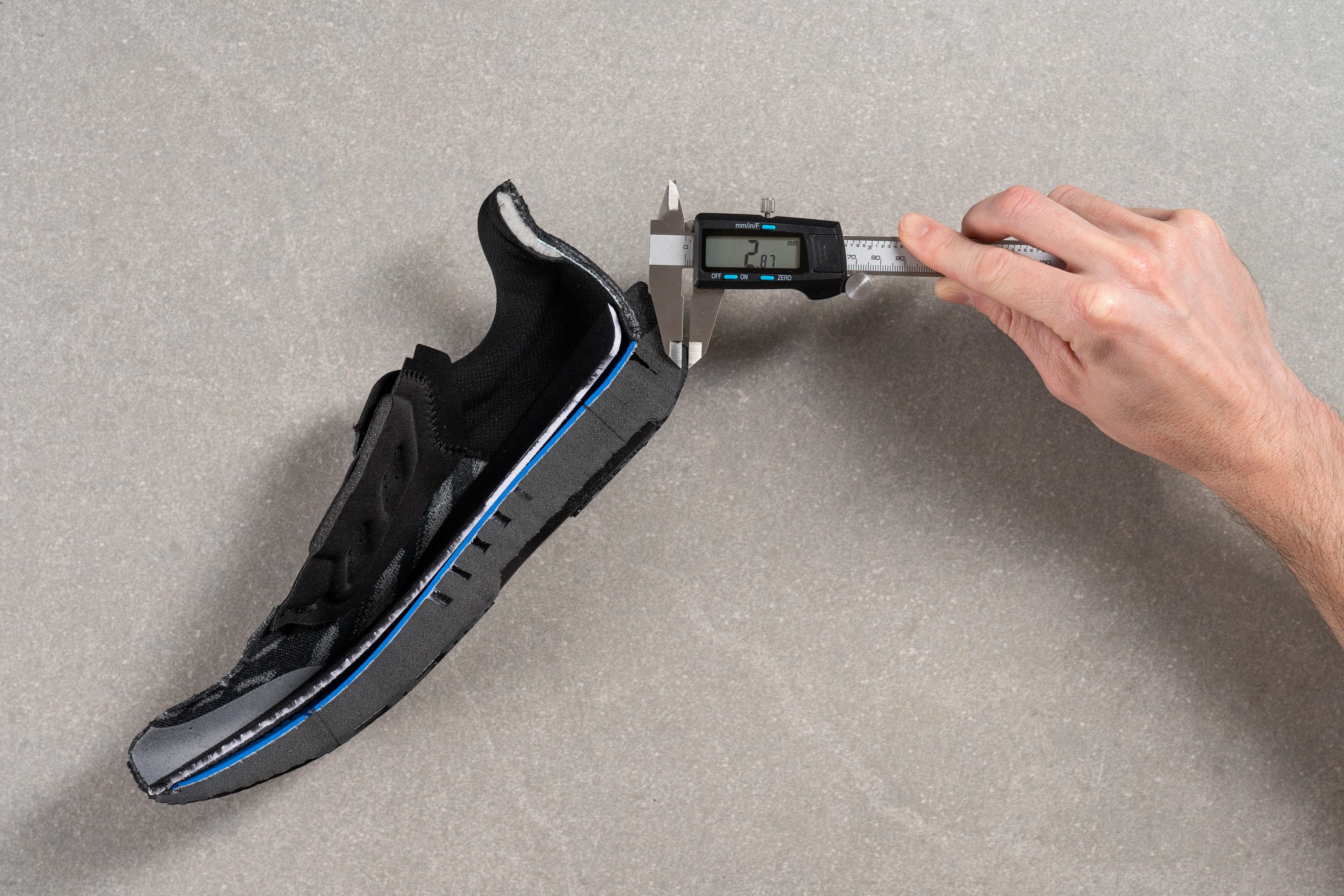
| Hyperion 2 | 2.9 mm |
| Average | 3.2 mm |
Misc
Insole thickness
We appreciate Brooks' cohesive design approach in the Hyperion 2. When the focus is on creating a leaner, lighter shoe, every element aligns with that vision—hence the minimalistic, paper-thin 2.9 mm insole that perfectly complements this shoe.

| Hyperion 2 | 2.9 mm |
| Average | 4.5 mm |
Removable insole
We had no issues removing the insole, but there’s a catch—it’s quite thin as we proved before, and the room inside the Hyperion 2 is really limited. In our experience, this setup means only ultra-slim footbeds will fit comfortably, as regular ones would likely make the toebox uncomfortably cramped.
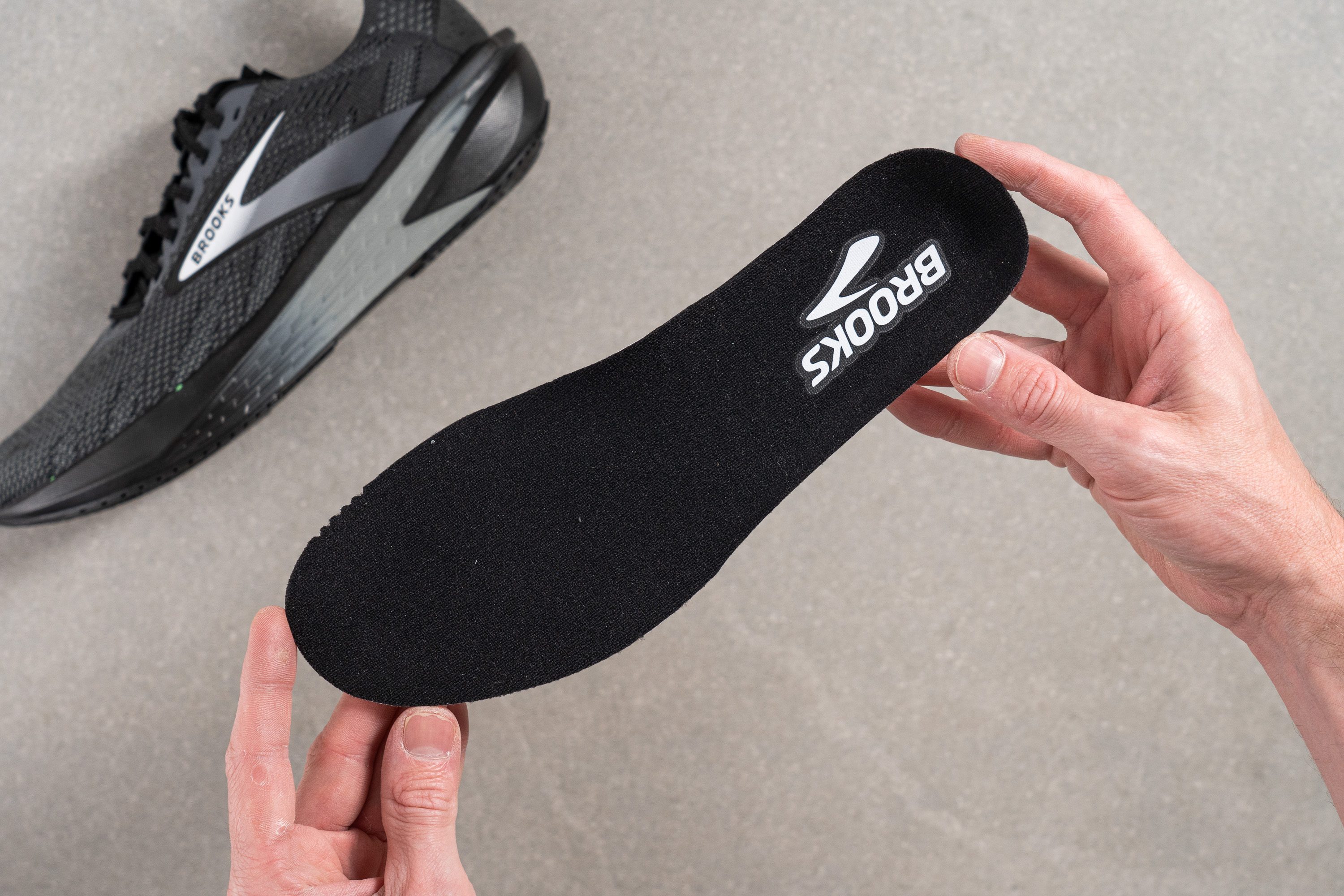
| Hyperion 2 | Yes |
Midsole softness in cold (%)
After chilling the Hyperion 2 in the freezer for 20 minutes, we retested its foam with the Shore A durometer. Our findings revealed a minor 18.6% change—a stellar result for an EVA-based foam!

| Hyperion 2 | 19% |
| Average | 24% |
Reflective elements
One of the few things we didn’t like about the Hyperion 2 is the lack of reflective elements. A small reflective detail on the heel or the Brooks logo on the lateral side would have been a welcome improvement.
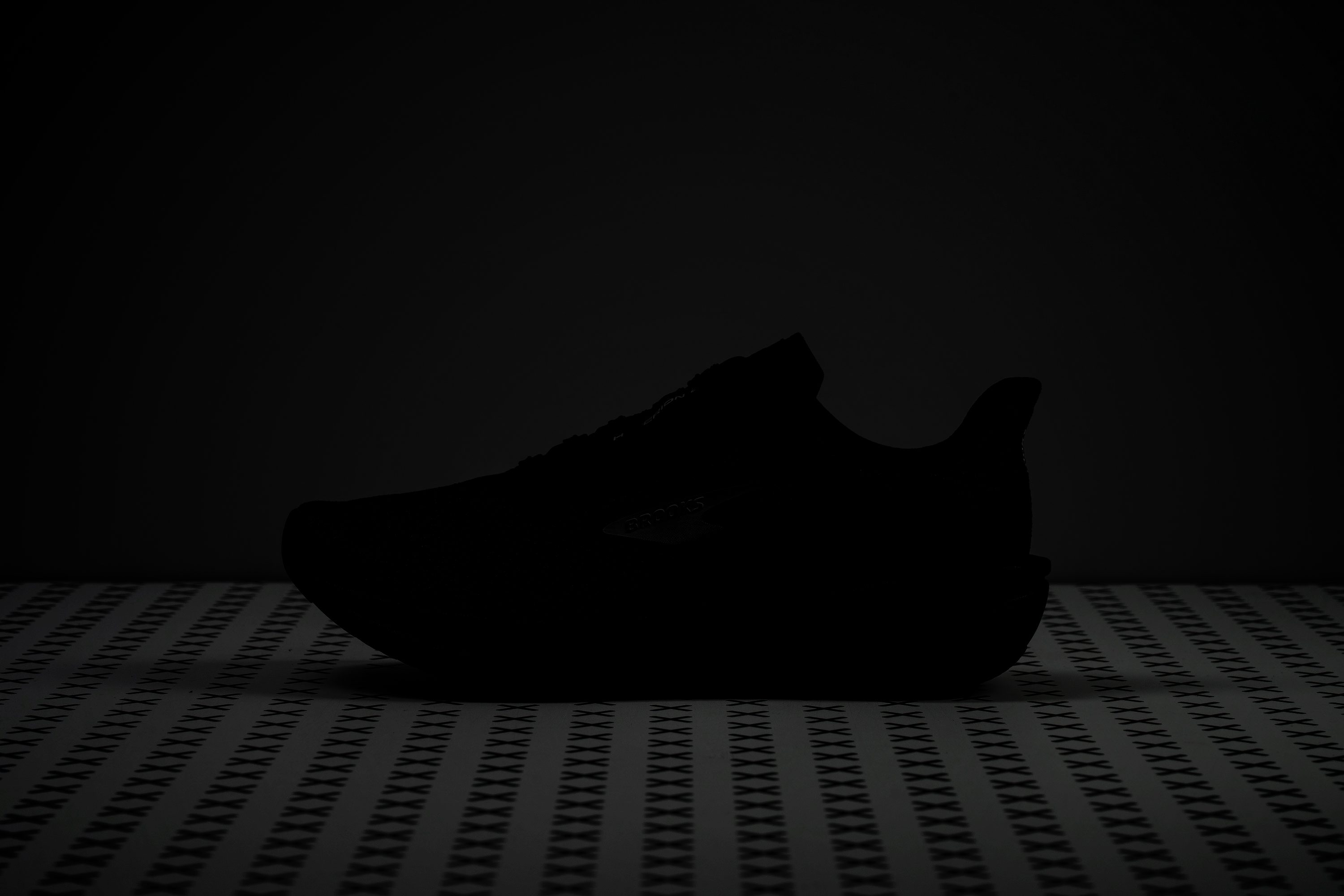
| Hyperion 2 | No |
Tongue padding
In our experience, the tongue on the Hyperion 2 is a substantial improvement over the first-gen Hyperion, nearly doubling in thickness (6.1 mm) for enhanced comfort. It’s cleverly designed with padding only where needed, maintaining a feather-light feel without compromising comfort.
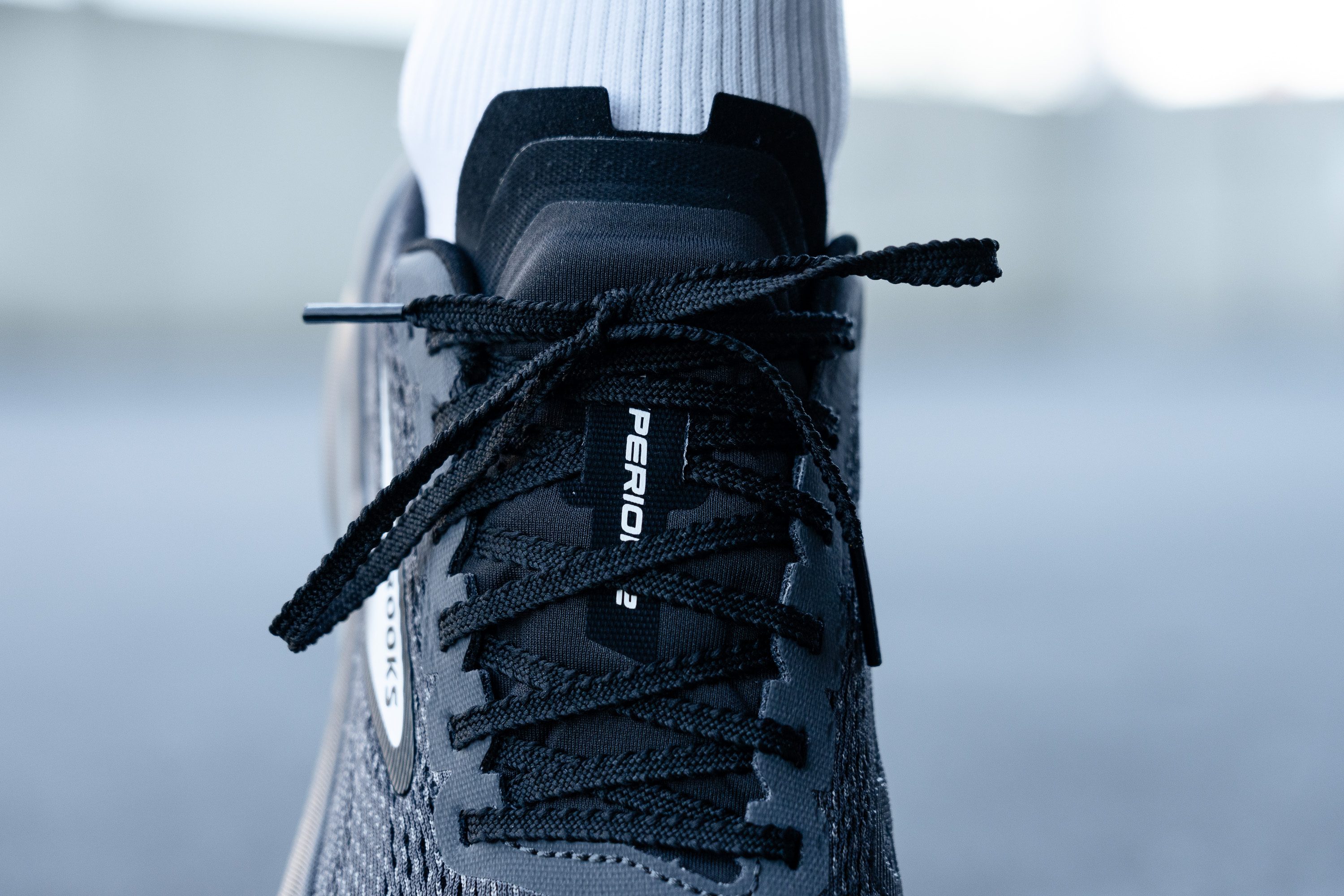
The lockdown is impressive—Brooks kept it simple but nailed the execution. We found that the Hyperion 2 uses punched eyelets for smooth adjustments and slightly textured laces that resemble those on supershoes like the ASICS Metaspeed Sky Paris, offering a high-performance feel at a much more accessible price.

| Hyperion 2 | 6.1 mm |
| Average | 5.8 mm |
Tongue: gusset type
The Hyperion 2 takes again a creative approach to tongue design, setting it apart from the 99% of running shoes that feature a symmetrical gusset on both sides. We love to see some rare, think-outside-the-box design!
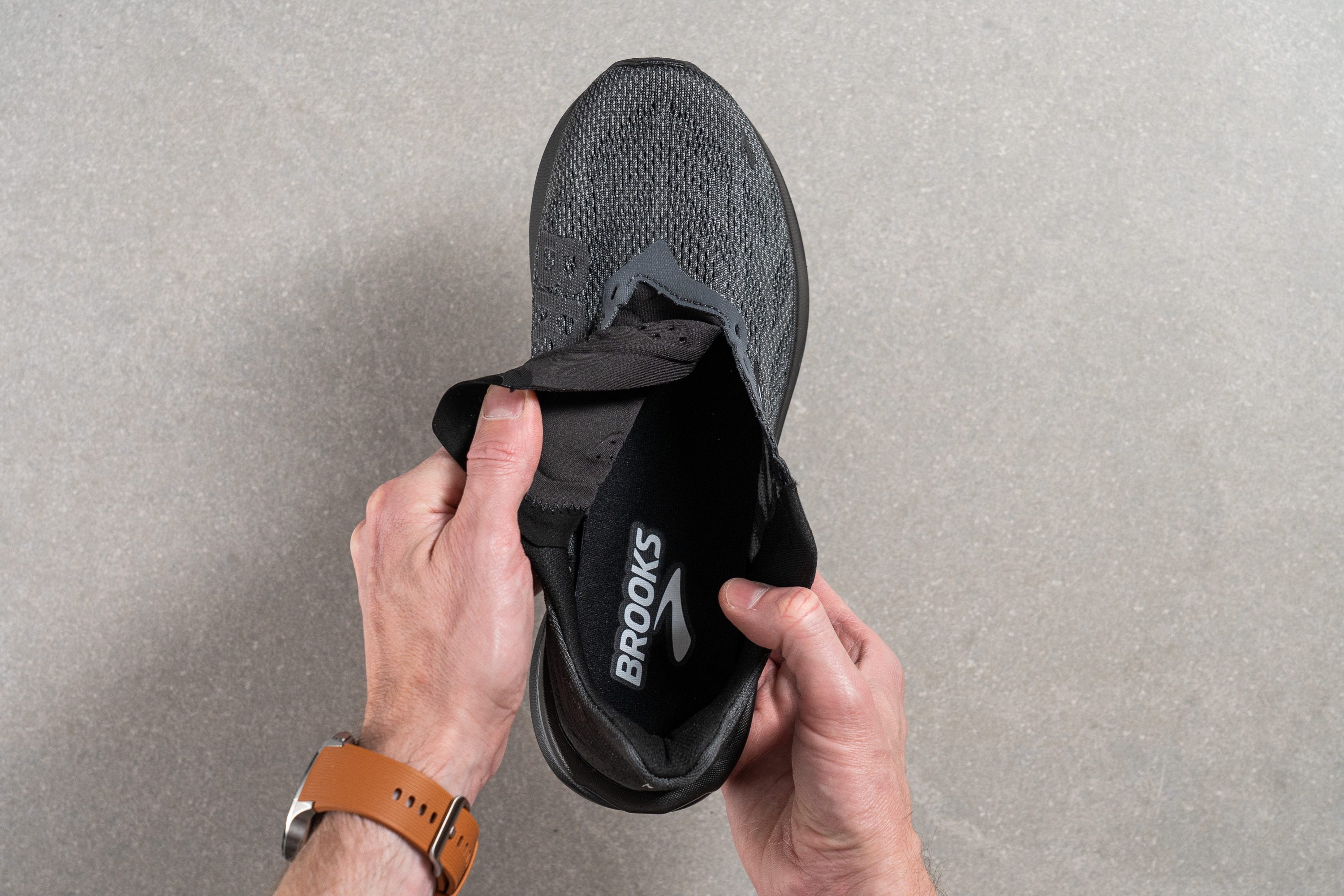
Brooks chose a think-outside-the-box approach, securing the tongue only on the medial side and allowing the lateral side to move freely.

| Hyperion 2 | One side (semi) |
Price
This shoe brings back nostalgic vibes from the good old days, offering a grounded, non-rockered ride that feels refreshingly classic. In our view, the price tag matches this retro appeal—making it one of the most budget-friendly choices for a performance trainer that can double as a dedicated 5K/10K racer.
| Hyperion 2 | $140 |
Heel tab
We found that Brooks opted not to include a heel tab in the Hyperion 2, similar to recent designs like the Ghost Max 2. However, they introduced a Hoka-inspired, extended heel collar that not only reduces pressure on the Achilles tendon but also makes it easy to slide your foot in.

| Hyperion 2 | Extended heel collar |

























































